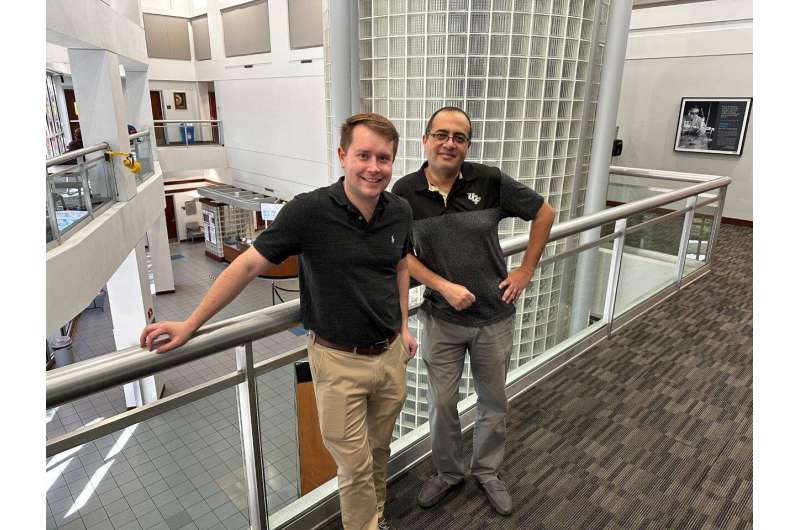First observation of de Broglie-Mackinnon wave packets achieved by exploiting loophole in 1980s theorem

University of Central Florida College of Optics and Photonics researchers achieved the first observation of de Broglie-Mackinnon wave packets by exploiting a loophole in a 1980s-era laser physics theorem.
The research paper by CREOL and Florida Photonics Center of Excellence professor Ayman Abouraddy and research assistant Layton Hall has been published in the journal Nature Physics.
Observation of optical de Broglie–Mackinnon wave packets highlights the team’s research using a class of pulsed laser beams they call space-time wave packets.
In an interview with Dr. Abouraddy, he provides more insight into his team’s research and what it may hold for the future.
You accomplished several ‘firsts’ during this phase of your research. Will you provide some history of the theoretical ideas that brought you here?
In the early days of the development of quantum mechanics almost 100 years ago, Louis de Broglie made the crucial conceptual breakthrough of identifying waves with particles, sometimes called wave-particle duality. However, a crucial dilemma was not resolved. Particles are spatially stable: their size does not change as they travel, however waves do change, spreading in space and time. How can one construct a model out of the waves suggested by de Broglie that nevertheless correspond accurately to a particle?
In the 1970s, L. Mackinnon proposed a solution by combining Einstein’s special theory of relativity with de Broglie’s waves to construct a stable ‘wave packet’ that does not spread and can thus accompany a traveling particle. This proposal went unnoticed because there was no methodology for producing such a wave packet. In recent years, my group has been working on a new class of pulsed laser beams that we have called ‘space-time wave packets,’ which travel rigidly in free space.
In our recent research, Layton extended this behavior to propagation in dispersive media, which normally stretch optical pulses—except for space-time wave packets that resist this stretching. He recognized that the propagation of space-time wave packets in a medium endowed with a special kind of dispersion (so-called ‘anomalous’ dispersion) corresponds to Mackinnon’s proposal. In other words, space-time wave packets hold the key to finally achieving de Broglie’s dream. By carrying out laser experiments along these lines, we observed for the first time what we have called de Broglie-Mackinnon wave packets and verified their predicted properties.
What is unique about your results?
There are several unique aspects of this paper. This is the first example of a pulse propagating invariantly in a medium with anomalous dispersion. In fact, a well-known theorem in laser physics from the 1980’s purports to prove that such a feat is impossible. We found a loophole in that theorem that we exploited in designing our optical fields.
Also, all previous pulsed fields that propagate without change have been X-shaped. It has long been theorized that O-shaped propagation-invariant wave packets should exist, but they have never been observed. Our results reveal the first observed O-shaped propagation-invariant wave packets.
The U.S. Office of Naval Research is supporting your research. How are your findings useful to them and others?
We don’t know yet exactly. However, these findings have practical consequences in terms of the propagation of optical pulses in dispersive media without suffering the deleterious impact of dispersion.
These results may pave the way to optical tests of the solutions of the Klein-Gordon equation for massive particles, and may even lead to the synthesis of non-dispersive wave packets using matter waves. This would also enable new sensing and microscope techniques.
What are the next steps?
This work is a part of a larger study of the propagation characteristics of space-time wave packets. This includes long-distance propagation of space-time wave packets that we are testing at UCF’s Townes Institute Science and Technology Experimentation Facility (TISTEF) on Florida’s space coast. From a fundamental perspective, the optical spectrum that we have used in our experiments lies on a closed trajectory. This has never been achieved before, and it opens the path to studying topological structures of light on closed surfaces.
More information:
Layton A. Hall et al, Observation of optical de Broglie–Mackinnon wave packets, Nature Physics (2023). DOI: 10.1038/s41567-022-01876-6
Citation:
First observation of de Broglie-Mackinnon wave packets achieved by exploiting loophole in 1980s theorem (2023, January 27)
retrieved 27 January 2023
from https://phys.org/news/2023-01-de-broglie-mackinnon-packets-exploiting-loophole.html
This document is subject to copyright. Apart from any fair dealing for the purpose of private study or research, no
part may be reproduced without the written permission. The content is provided for information purposes only.
For all the latest Science News Click Here
For the latest news and updates, follow us on Google News.

